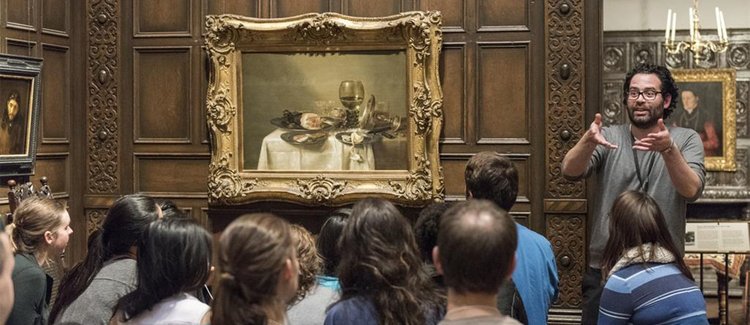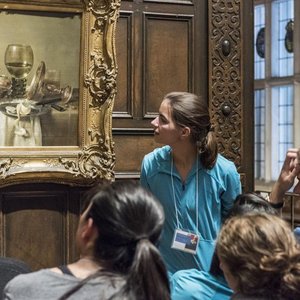
A few times each month during the fall semester, first-year medical students in the Perelman School of Medicine at the University of Pennsylvania take a break from their typical classrooms on campus and head across town to the Philadelphia Museum of Art. These students are not just visiting the art museum to take their minds off of studying; they are enrolled in a course called “Art, Observation, and Empathy” that ties together traditional concepts taught in art and applies them to medical training.
The course, "Art, Observation, and Empathy," is now in its fourth year and the goal of the course is to help medical students build their observation and communication skills through art. It takes them out of a clinical or classroom setting and puts them somewhere unfamiliar. Instead of discussing potential symptoms and diagnoses, they discuss an artist’s decisions, context, and inspiration.
“By taking medical students out of their comfort zone and bringing them into the new context of the museum, students are faced with the challenge of interpreting artworks and artifacts that aren’t easily understood,” said Adam Rizzo, museum educator and school partnerships liaison at the Philadelphia Museum of Art. “Penn Med students are among the best and the brightest, and as such are used to being right and having the correct answer. Part of our job is to remind them that there isn’t always a right answer or even one answer. Art is a great way to explore that concept.”
Across seven sessions, students develop thinking dispositions such as observing and describing, comparing and connecting, questioning, investigating, and exploring viewpoints. The curriculum is based on research conducted by Project Zero at Harvard University, which developed “Artful Thinking” routines to help students develop these dispositions. The course focuses on a variety of artworks, from Indian temple sculpture to colonial portraits to Dutch still life paintings. But the goal of the course is to teach students to think more reflectively about what they see and then apply that to medicine.
“We are using art as a tool to train medical students to be better observers and communicators so they can become better doctors,” Rizzo said. “A large part of that is building in time during each session to reflect on our activities in the galleries, discuss what the process of going through these thinking routines feels like, and how the skills we are practicing might transfer to the clinical context.”
And now there is academic research to back up this idea. Published earlier this year in Ophthalmology, Rizzo and fellow Philadelphia Museum of Art colleague Suzannah Niepold, manager of teacher services, along with Jaclyn Gurwin, MD, an ophthalmology resident in the Scheie Eye Institute at the University of Pennsylvania, and other Penn researchers, compared the skills of students who took the “Art, Observation, and Empathy” course with those who did not. They saw significant improvement in observational recognition skills among the students who took the course and demonstrated that art training alone — without a clinical component — could help teach medical students to become better clinical observers.
"The skills I learned studying fine arts in college are invaluable to me now as a physician. I saw the impact art education had on my approach to medicine, and I wanted to recreate that experience for others in the field,” Gurwin said. “The results of this study are incredibly encouraging, showing that art observation training can improve observational skills. We hope this training will translate to improved clinical effectiveness, empathy and, ultimately, will make better physicians."
The study results — with their measured analysis of the students’ improved observational abilities — are one thing, but anecdotal responses to the course have also been promising, as the research team found through post-study questionnaires and discussions. Students who received the training indicated that they are already applying their course-learned skills in clinically meaningful ways.

Students also shared improvements in their ability to see others’ points of view. This may suggest that the impact of their art training — which placed them in a listen-first environment where multiple viewpoints were encouraged to deal with complex, sometimes subjective topics — is preparing them for everything from the bedside to the collaborative diagnostic environment.
“I think my biggest takeaway was appreciating teamwork and the perspectives of other people,” said Christy Hong, a fourth-year medical student in the MD-MBA program at Penn, who participated in the art training as a first-year student. “It expanded my definition of what makes a good scope of observation. But my observation alone isn’t enough. Medicine is a team sport. I always seek the opinions of my colleagues on the floor, if possible, to get a fuller sense of what’s going on and to be able to triage it more appropriately.”
The impact of the course — anecdotal and otherwise — is encouraging. Art analysis might soon become a regular component in overall medical training.
Contributed by the Perelman School of Medicine at the University of Pennsylvania